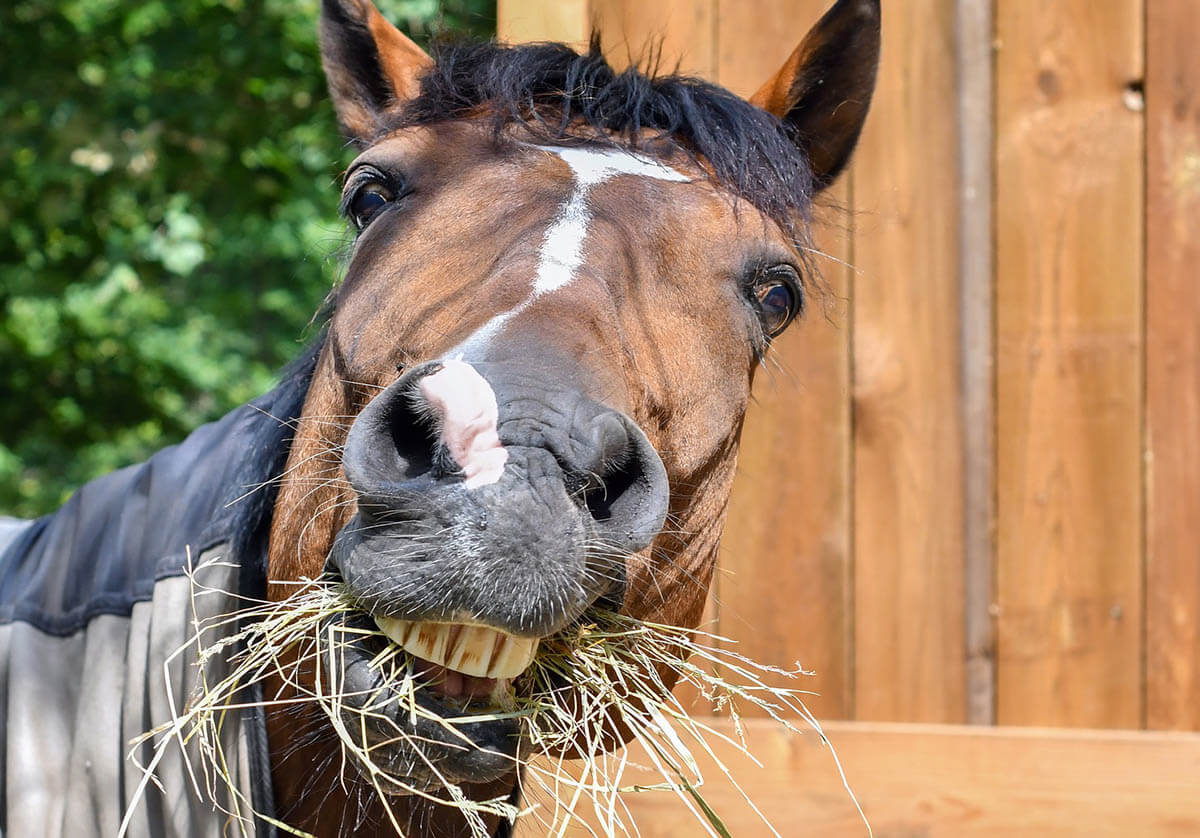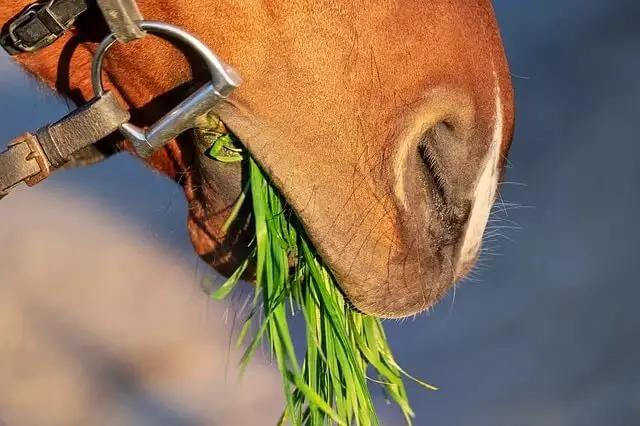The horse pasture is not infrequently the place where the animals spend most of their time from spring to autumn. But so that they can draw enough nutrients from the grasses and herbs and not mix in poisonous plants, they also require a certain amount of care by humans. We explain here what that means in concrete terms and what you should pay particular attention to!
The Tasks & Challenges of the Horse Pasture

When you think of horse pasture, do you first think of the basic feed that it is supposed to offer? Or is it perhaps a picture of horses frolicking and playing? The fact is that the pasture is not only there for grazing, but also forms the habitat of the animals. It must also meet these requirements accordingly.
But what exactly does that mean? As a rule, horses will cover 15 to 20 km a day in the pasture, provided that it is large enough. The constant running back and forth is a burden that the paddock must be able to withstand first. In addition, the animals roll around here, will play with each other, and of course not just walk at a step. These factors result in a small to-do list that you should check before putting your animal out on the horse pasture:
- Examine the sward for damage: In the case of molehills or tread damage, regular leveling or dragging of meadows is important.
- Hygiene: Horses don’t like standing in their own manure, so poo regularly.
- Mowing: The horses actually mow, but if some grasses are left standing (e.g. because they don’t like them), this can also affect the growth of other varieties. In such cases, you should mow it yourself.
- Fertilization: A regular and species-appropriate fertilization ensures a nutrient-rich pasture.
- The seeds: The horse pasture should be sown and sown regularly. On the one hand, the damage is repaired and, on the other hand, important grass and herb varieties are maintained.
The Perfect Horse Pasture: That is What You Need to Consider
Have you just taken over a new pasture area? Or do you want to check whether your horse pasture is still suitable as such? Then there are various points that you should take a closer look at. It is best to start by having the soil and the growing grass examined by a specialist. This will give you an initial insight into the potential measures that are ahead of you.
Find the Right Seeds
Horses have certain demands on their habitat, we have already mentioned that above. These challenges also result in which grasses are best suited for pasture. Sturdy and weather-resistant species are often welcome, as they reduce the number of turfs. However, these are usually also very rich in sugar and protein, which is not ideal for animals. Not only the composition itself but also the frequent symbioses with mushrooms do not make these varieties the best source of food.
Mixtures of grasses low in fructan and with a high proportion of herbs are more suitable. These are also good for overseeding. However, these often only germinate very slowly and thus offer space for weeds, clover, or even poisonous plants to spread. So if you are re-sowing a pasture, it is best to use a mixture of the above-mentioned and the particularly resistant variants.
Speaking of sowing and overseeding: You may now be wondering when this process is best to take place. For the sowing itself, the spring months of March or April are usually set. If you want to plow and fertilize the area around the pasture, it is best to start in autumn (preferably in mid-October) so that the paddock can relax long enough.
Between Grasses, Herbs, and Weeds
Are you now wondering which plants are suitable for horse pasture in detail and in what proportion? Or which ones shouldn’t you prefer? So what does the perfect seed look like? Then we would like to give you a brief overview here. But be careful! Every pasture is slightly different and, depending on the quality of the soil and the location, some grasses, and herbs grow better than others. Let’s start with the grasses:
Type of grass Optimal proportion in the horse willow seed
Timothy grass <40%
Meadow foxtail <25%
Red fescue <15%
Meadow fescue <10%
Knucklegrass <10%
Meadow panicle <10%
German ryegrass <10%
French pasture grass <5%
You are welcome to find all of these grasses in the seed mix because this way you can be sure that some will always prevail and displace the weeds. In addition, this base should then be replaced by some herbs, which provide the horses with additional nutrients. These include:
- Bibernelle
- Nettle
- Fennel
- Little meadow button
- Caraway seed
- Bedstraw
- Parsley
- Marigold
- Yarrow
- Ribwort plantain
- Chicory
- Wild carrot
In addition, there are also some weeds and plants that should by no means be found on the horse pasture, as they are poisonous for the animals. So it is best to always take a close look at the grasses and remove the following as quickly as possible, including their roots:
- Bracken
- Sycamore maple
- Blue monkshood
- Yew
- Spotted hemlock
- Laburnum
- Autumn crocus
- Ragwort
- Johannis herbs
- Lily of the valley
- Black locust
- Red thimble
- Black deadly nightshade
- Thorn apple
The Nuts and Bolts of Fertilizing Horse Pasture
We have already mentioned: the soil of the pasture should also be examined carefully. To do this, send a sample to an appropriate institute. You can use these results to create a fertilization plan that ensures that your paddock always provides the best possible feed base for your animal. What you shouldn’t do, however, is just fertilize by feeling – you can often do more harm than good with this.
Natural vs. Artificial Fertilizers

Which fertilizer you use basically depends on the soil conditions. However, a combination of liquid manure, i.e. animal manure, and artificial fertilizers is often useful. The liquid manure should best be obtained from cattle or pigs. This harmonizes best with the grasses and herbs on the horse pasture.
If you use an artificial fertilizer in addition or exclusively, it should ideally be specially advertised for horse pastures. After all, this grassy landscape is exposed to special challenges and needs to be cared for accordingly. Special horse manures contain a balanced proportion of minerals and nutrients for plants and animals. The following are particularly important here:
- Magnesium: is an important component of many metabolic processes in horses and is contained in leaf green. With additional fertilization, more can be absorbed and processed.
- Phosphorus: Ensures that plants take root better and at the same time push back weeds. In addition, phosphorus is an essential component of horse bones.
- Sodium: This is particularly important for horses in summer, as they lose a lot of salt through sweating. Also makes the grass tastier.
Caution! As important as fertilizing horse pasture is, always make sure you use the right amount and stick to the plan. If you only work with liquid manure or only with artificial fertilizer, the values also vary. A combination of both is often the most sensible measure.
Beware of Hyperacidity
One of the most important things to have your pasture soil checked for is pH. This should usually be between 5.8 and 6.2. However, it is often the case that it is too low and thus the soil is over-acidic. Conversely, this also means that the sown plants grow only slowly and can hardly absorb nutrients through their roots.
Scattering lime can help to counteract this. This can rebalance the pH value and counteract acidification. The best time for such a treatment is autumn. In the spring, the values for the new sowing should look significantly better.
What if the Pasture Gets Too Dry
Do you keep struggling with dry horse pastures? This can happen quickly, especially in summer, because the solar radiation is intense, but the rainfall is rare. When the grass turns yellow and brown, it contains significantly fewer nutrients. In these cases, you should resort to additional roughage (hay and straw) and concentrated feed to compensate for the nutritional deficiencies.
If the drought lasts for a particularly long time, it can also happen that the grasses die off completely. In this case, you will need to re-sow them and let them grow. In order to prevent this, it is important to protect the meadows and to put the horses on the substitute meadow as a precaution. This way, there is no unnecessary turf that would allow the soil to dry out even further.

